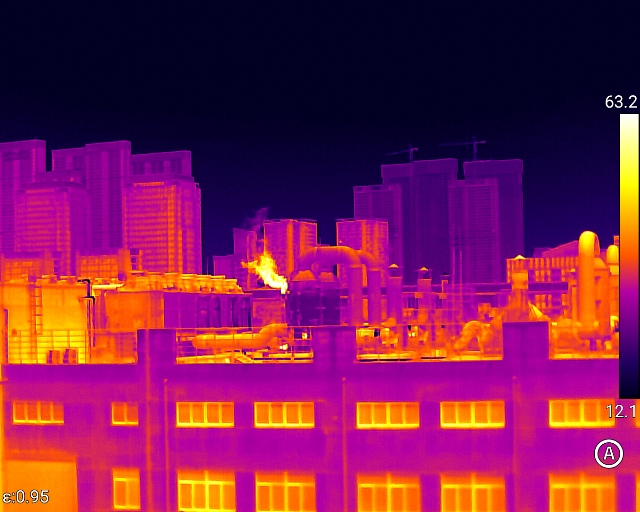Substations are crucial for power transmission, stepping up or down voltage to ensure the flow of electricity to homes and factories. But when large amounts of electrical equipment are running all the time, heat generation can cause serious problems, like power loss or fire. That's where infrared thermal cameras come in. Infrared thermal cameras can "see" heat, so they are ideal tools for identifying potential problems before they escalate. Here are some particular applications for them in substations.
Checking Electrical Connections
Electrical connections, such as terminals, wires, and bolts, can loosen over time. Once loose, they increase resistance, which generates unwanted heat. Infrared thermal cameras can capture this heat without touching the equipment.
Workers patrol the substation with thermal imaging cameras, scanning the connection areas on transformers, circuit breakers, and switches. Hotspots in thermal images indicate a sign of loose or corroded connections. Early repair of these problems prevents them from melting or causing short circuits. This method is vastly faster and more efficient than manually inspecting each connection point in large substations.
Monitoring Transformers
The heart of a substation is the transformer, which is used to change voltage levels. Overheating can signal oil leaks, coil failure, or even complete failure. Thermal imaging cameras have the capacity to monitor transformer temperatures while in operation, without shutdown.
Thermal imaging cameras can reveal the heat distribution patterns on the transformer surface. A normal transformer has even heat distribution. If a region is significantly hotter, it could indicate an internal problem, e.g., shorted coil. From this, staff can take action, e.g., adding more cooling oil or scheduling maintenance, to prevent transformer failure.
Check Switchgear and Circuit Breakers
Switchgear and circuit breakers control the flow of electricity. When they are worn out or dirty, components like contacts tend to get hot. This is an indication that they are likely to fail when they are most needed, such as during a power surge.
Infrared thermal cameras scan these components during routine inspections. Hot contacts indicate that a circuit breaker is not closing properly, which can lead to arcing and fire. By identifying such hot spots, workers clean or replace parts in advance, ensuring reliable switchgear operation.
Improve Safety During Inspections
Substations are dangerous places, where high voltage is enough to kill a person immediately. Thermal image cameras allow workers to inspect equipment from a safe distance, without having to open panels or approach live components.
This is particularly handy for emergency cases, such as after a storm. The workers can quickly scan for hot spots or equipment without electrocution risk. This keeps them safe while ensuring the substation is quickly restored to normal operations.
Assisting with Preventive Maintenance Planning
Infrared thermal cameras not only detect short-term issues but also support maintenance planning over the long term. By scanning equipment periodically and storing thermal images, workers can monitor temperature variations weeks or months later.
For example, if a switch exhibits a slow temperature increase over three months, this indicates that the component is gradually wearing out. This data allows the maintenance crew to replace it when the substation is in scheduled downtime, as opposed to addressing sudden breakdowns. This moves away from guesswork to a preplanned approach, making substation operation more efficient.
Assessing Equipment Aging
Electrical equipment in substations naturally ages over time, which affects its performance. Thermal image cameras help assess this aging process by comparing the heat distribution patterns of older and newer equipment.
For example, an aging capacitor bank may exhibit uneven heat distribution compared to a new one, indicating that its internal components are aging. This allows employees to estimate the remaining useful life of the equipment and decide whether to repair or replace it, thus avoiding unexpected failures that could disrupt power supply.
Integration with Intelligent Systems
Modern infrared thermal imaging cameras can integrate seamlessly with substation intelligent management systems. The thermal data they collect is automatically sent to a central platform for real-time analysis by software.
If there is any sudden increase in temperature in any part of the equipment as picked up by the system, it automatically alerts the maintenance crew. This integration makes monitoring more efficient without the need for workers to patrol and inspect each piece of equipment manually, which allows for quicker issue resolution. It is one key feature of substations being smarter and more reliable.
Conclusion
Infrared thermal cameras are revolutionizing substations. They can easily detect overheated components, sweep large equipment like transformers, give workers assurance of safety, assist in preventive maintenance planning, inspect equipment wear and tear, and be integrated into smart systems. By detecting problems early, they reduce downtime, prevent costly breakdowns, and offer a stable source of power. If you are interested in this device, please contact us.













.svg)


(1).jpg)
(1).jpg)

